1/26/20
3rd graders are currently working on animals in sweaters -
Anthropomorphism......which many artists and illustrators enjoy creating.
(even really famous artists like William Wegman...
 |
| William Wegman |
and not so famous ones like Indra Sanchez).
 |
| Indra Sanchez |
It is a smaller and quite fun project. The kids have been working hard...so its nice to slow the pace a little.
They will be displayed soon in the hall.
Well the Gabriele Munter paintings are complete - some are displayed in the hall and the remainder are mounted and stowed away for the art show.
Gorgeous as usual...I must say!
Remember they mixed ALL their colors from the primary colors plus white. All that variety - they concocted themselves.
11/14/19
3rd grade-
Architecture is a throughline theme in 3rd grade. We will weave it into several projects.
We began the year the year reading the book by Maya Angelo
“My painted house, my friendly chicken and me.” In the past I have led a drawing project
connected to this theme - but this year - I decided to have the students make a model Ndbele House.
They loved it and in the process learned several paper sculpture techniques that we continued and will expand upon later this year.
We began the year the year reading the book by Maya Angelo
“My painted house, my friendly chicken and me.” In the past I have led a drawing project
connected to this theme - but this year - I decided to have the students make a model Ndbele House.
They loved it and in the process learned several paper sculpture techniques that we continued and will expand upon later this year.
The Ndbele women are the painters of their beautiful homes in South Africa.

There is some new information that the paintings have some symbolic meaning, in color and design. We came up with our own coded symbols and the students combined them to tell about themselves and also guide their designing process.

We took the enthusiasm for this and additional paper sculpting skills and channeled it into making their haunted houses.
I have never had such a developed group of spooky buildings. They did a fantastic job.
I have never had such a developed group of spooky buildings. They did a fantastic job.

Currently students are drawing homes typical of the northwest but we are reading about homes from other parts of the world.
Students are becoming aware that buildings reflect different local needs for protection from the weather, other reasons for security, and available materials.
We are pivoting towards students drawing their own house or apartment, or an imaginary building, inspired by the paintings of Gabriele Munter.
Students are becoming aware that buildings reflect different local needs for protection from the weather, other reasons for security, and available materials.
We are pivoting towards students drawing their own house or apartment, or an imaginary building, inspired by the paintings of Gabriele Munter.
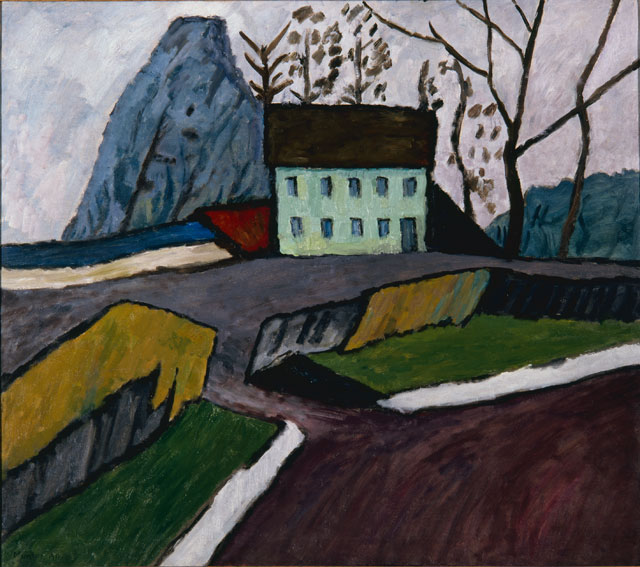
This will be a chance to make a large painting and practice lots of color mixing, as the students will only be given primary colors plus white, to work with.
This is an enthusiastic bunch of artists and a pleasure to work with.
Thank you,
Nancy Helmsworth

4/8/19
The Jonathan Green inspired work will be on display in the Capitol Hill Art Show - 4/11/19 - 6:30-8:00pm.
Students did a short project using their creative minds and practicing their drawing skills - featuring "overlapping lines."
Crazy Hair Day
Wow they had some wild ideas and some strong skills.
(Next up a study of Joseph Stella and his Brooklyn Bridge series as an introduction to the students' Portland Bridge Abstractions)


2/5/19
We are now learning about African American artist Jonathan Green - and his paintings of the Gullah area off the coast of South Carolina and Georgia.
He is descended from slaves who lived and farmed on the islands quite remote from the plantations. Because they had that space, they were able to have a little more autonomy with their culture.
We listened to the McIntosh County Shouters yesterday as we worked on our projects - music from this African American culture.
https://youtu.be/uxPU5517u8c


As Jonathan Green's childhood memory paintings are based on the pleasure of simple chores, students are asked to illustrate a simple chore or task they do, like caring for a pet, folding laundry or taking out the trash. They are hard at work on this drawing - using our nice water color crayons to complete the work.
Here are some of the completed Demuth inspired drawings.
11/5/18
Third graders are coming to art class every Monday for one hour.
We will return to the topic of architecture, but are taking a break to look at the art of Charles Demuth.
https://www.metmuseum.org/art/collection
"I saw the figure five in gold" is a 1923 painting by Charles Demuth inspired by his friend the poet William Carlos Williams. The poem describes a fire truck racing down rainy city streets at night.
We will also read the book about William Carlos Williams
A river of words
Students will be asked to compose a picture in 3 layers - foreground, middle ground and background, using a number 3 times, a shape (used 3 times) in the middle ground - and create a background.
It is a tricky challenge, but creating art featuring a number is often lots of fun for the kids. I hear a lot about "my favorite number is...." Good!
Here are some of their thumbnail sketches as they exercise their brains for creative practice and test ideas:
We began the year with a new type of self-portrait - "Shadow Self-Portrait." The construction puts a new spin on a classic assignment and the results are fun. No doubt you saw some of these displayed in the hall and in the kids' classroom.
We began our discussion about Architecture and the students created a 3-D haunted house energized by Halloween enthusiasm.
4/15/18
3rd graders are completing their study of Jonathan Green - a contemporary African American artist who lives in South Carolina.
He is a painter who makes work based on his childhood memories of growing up on the Gullah Islands.
His ancestors were slaves working on the plantations there, growing rice and indigo.
Though the community was poor during his childhood, he shows scenes of everyday beauty, playing or doing common chores.
His colors are bold and the patterns are exaggerated.
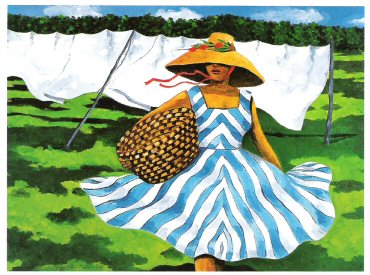

For our assignment, we brainstormed chores or some simple pleasures that we experience and set out to illustrate them.
"walking the dog, folding warm from the dryer laundry, making lunches..."
The kids came up with some pretty nice drawings. They are using the watercolor crayons and blending them as a last step. It is a fun material to work with.
I'll take some pictures of the students' work as they complete them in the next couple weeks.
Students have completed their Ndebele Houses, inspired by the Ndebele tradition of women painting the exterior of their house.
This beautiful tradition is from the area of South Africa and continues on today. There is some thinking that some of the shapes were for communicating messages, but that information is not clear enough to teach as fact.
Our students were inspired by the symmetry, black outlining and bold colors uses and how each building was unique.

Our art project was to design a building in the Ndebele style and use oil pastels to lay in an under-layer and add decorative patterning on top. Layering oil pastels is what that media is meant to do.
1/21/18
The Gabriele Munter paintings are now complete and being stashed away for the CH Art Show.
Students were even asked to write a story about who lives in their house and believe it or not...there are lots of ghosts! Maybe I should have given them and better prompt...oh well.
11/5/17
Architecture has been our theme for a few weeks now. There is way too much to think about, but we will look at it several ways and maybe even return to it later in the year.
Students have practiced drawing houses with an awareness of how a house is built. We read a basic book on the subject, but many students had recently watched building around the neighborhood and were familiar with the process.
A simple connection was the drawing of a haunted house around the time of Halloween. The kids had fun connecting both themes in their paper bag house.
In the last class students were given the opportunity to stamp a "blue print."
Now there was no planning of ideas, so kids just improvised. With that approach some will be happy and some will want another chance to make their print differently. I think we can make that happen.
Here they are making their prints.
This week students will learn about "elevation and plan drawings" and get to work with graph paper. They will also get to draw back into their blueprints to add information about furniture or room usage. Having time to experiment a little and discover by doing is the goal.
The big project of this unit is to look at the art of Gabriel Munter
(I saw this one at the Milwaukee Art Museum this summer. She is one of my favorite artists.)
and make a painting of their own house, or house of their dreams.
This work will take us to the winter holiday time at the very least.
October
After supporting the classroom teachers with their beginning of the year self-portraits, I took a cue from Ms. Younie and her expanding curriculum about maps.
I too have taught a unit about maps as a graphic way to communicate.
We ready Sara Fanelli's "My Map Book" for ideas about what we could map or show graphically. The stance was to keep this project more open-ended and let the students explore their ideas in different ways.
They got the hang of it - but can be a challenging transition from idea to presentation.
Here are some of what they came up with:
 |
| Traditional- but beautiful |
 |
| Favorite beverages, favorite ice cream flavors |
2/8/17
This year I seem to be doing more printmaking, or maybe it is just the timing of having 2 groups making prints.
The 5th graders just completed their beautiful Warhol Endangered Species prints and the 3rd graders are just organizing and titling their 2 color "Plant Prints."
The Plant prints was an idea to apply our plant drawing/observation lesson to a different medium. The students did some delightful prints - though 2 steps was a little challenging for this particular group. Maybe it was because they were hungry as our meeting time is right before lunch. Regardless, my plan is to show these in the Capitol Hill Art Show and I know you will enjoy them.
11/2/16
the painter of the "Blue Dog."
Here is the slide show to give you some background information.
George Rodrigue
One of my goals as a teacher is to help the students get a little more context for what and why we are doing our projects. Rodrigue worked in New Orleans which a rich culture different than our own in the Pacific Northwest.

Students are using their sketchbooks like real artists to plan their mixed media painting inspired by Rodrigue.
10/3/16
Here are some of the works in progress...
9/15/16
We are beginning the year with a look at the work of Charles Demuth and his poem inspired painting. This work is considered one of the first pieces of American modern art and it was painted in 1938!
Students are analyzing the work, by careful observation while sketching it and noticing the foreground, middle ground and background.
Soon they will compose their own number inspired piece and control their use of warm verses cool colors.
 |
| Charles Demuth "I saw the figure 5 in gold..." |
The Great Figure
Among the rain
and lights
I saw the figure 5
in gold
on a red
firetruck
moving
tense
unheeded
to gong clangs
siren howls
and wheels rumbling
through the dark city
5/15/2016
Students had a chance to learn about the history of appreciating Koi, a Japanese tradition that began in China.
As we were reminded that April was "poetry month" students were asked to write a haiku to go with their Koi.
Their poems were fantastic! Wow, what good writers.
3/27/16
3rd graders have been learning a lot about Chinese Calligraphy and connecting it to Chinese common symbolism.
China is quite a diverse country in terms of varied ethnic background and language.
Learning a little about the history of Chinese painting and how it was connected to the royal scholars and written calligraphy is how we began.
Here is the first part of a video we watched about the history of painting. There is information for sure, but also there is value is just getting a feel for the foreignness of China.
Students were introduced to the very proscribed Chinese approach to painting with defined ways of making the marks on the paper, even when shading.
As we are Americans and have an art culture of inventiveness and individuality, students were asked to experiment with brush strokes and come up with their own "patterns." They were to name them (so they could refer back to them and identify them) and then take turns teaching them around their table groups.
That done, students learned about some common symbolism is Chinese culture - such as a chrysanthemum is a symbol of long life for those in their "sunset" years.
Students were asked to put all their new skills together - painting a Chinese symbol, filling it with their new patterns and writing the symbols meaning in chinese characters....phew.
They did it and they appeared to really enjoy the challenge.
1/25/16
One of my favorite challenges is to think of ways to introduce the students to the profession of "product designer."
Portland clearly has a major industry of design with sportswear and other products. I want the students to know that a human with an art background and design training is involved in many of our local, highly developed, technically articulated products.
In the 4th grade students will do a unit about backpacks - their history and design. My goal is to think of a topic for each grade level. I am not there yet for all - but last year I saw a student do this and I "borrowed" her idea.
Telephone! (thanks AB)
Telephones are pretty amazing and are in another period of rapid evolution. Smart phones are also highly designed...but you could argue that is true for all phones through history.
Students were shown several youtube videos about the history of phones and how they work. Here is the link to our inspiration.
1965 at&t- how a telephone works, phone manners
how cell phones work
phones through history
Their assignment is to make a smart phone or tablet with at least 3 screens. I will laminate them and they will assemble them with a jump ring.
What students are including in their phone is so wonderful and will soon feel like a time capsule of sorts - capturing a view on their 3rd grade perspective on this fast changing technology.
12/16
Students were working on a plant drawing when Ms.Younie gave us some unused canvases.
I decided we would put them to use and connect them with the plant drawing-realism theme.
The canvases are to be holiday gifts, so many of you parents will see some of them soon.
A few students dropped the ball on this challenging project - but most did a spectacular job!
It was a difficult job for the 3rd graders, as they had to "self-manage" their behavioral temptations, when they switched from the painting back to the drawing. :0
Anyway here are a bunch of the successful paintings.
10/22
Here are a few of the completed Blue Dogs!
10/17/15
Blue Dog by George Rodrigue
George Rodrigue was (recently died) a painter living in New Orleans. He had formal art school training and after his return to his home in NO he developed a style focused on a device - a blue dog. The blue dog is the focus of all his work for years and was derived from the memory of a childhood pet + the Loup-garou - a french folk tale about a werewolf type creature.
As I explained to the students a device is something some artists use in their creative process. Something is fixed, unchanging in their work and is an anchor around which the artist is free to experiment. You can see this is Rodrigue's paintings, he experiments like crazy around the blue dog and even with the blue dog.
His work is lots of fun to look at and the students love it.
So as you might imagine, they are making their own "Blue Dog" art and are quite excited.
Here is Rodrigue's work.
early work, showing New Orleans setting
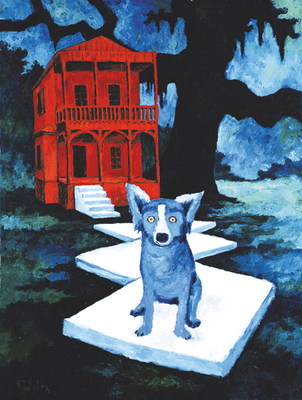
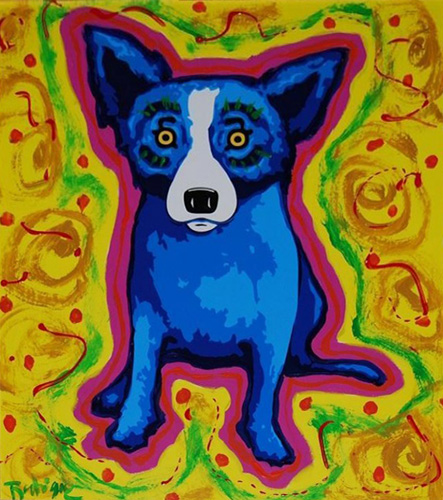

10/1/15
Self-portraits are a good way to begin the school year and Roy Lichtenstein with his comic book style is a natural venue for the students to tell more about themselves.
We began by looking at Lichtenstein's work and appreciating his comic book style of painting.
He featured high drama and primary colors in his paintings.


Here is some of the completed student work.
With their
"I am _,_and_." thought bubble
"I like to _,_, and_. " speech bubble
and onomatopoeia Sound shape
enjoy:
5/31/15
Charles Demuth
This is a project that I have been doing for years. It is simple, the students can do it as non-representational and I can introduce the kids to the concept of warm and cool colors.
Often I am emphasizing how to create a "sense of 3-D space."
Foreground-large, middle ground middle and background small. Objects in front are complete, behind are interrupted = overlap. Warm colors come forward and cool colors go back or recede.
Charles Demuth was an American painter in the early 1900's. He was also friends with William Carlos Williams a doctor and famous poet. We begin the project by reading about WCW and his poem "I saw the figure 5 in gold," and the students are charged with finding the connection to the painting.

The Great Figure - William Carlos Williams
Among the rain
and lights
I saw the figure 5
in gold
on a red
fire truck
moving
tense
unheeded
to gong clangs
siren howls
and wheels rumbling
through the dark city
Then the students are set free to make their own warm and cool drawing using numbers, shapes and a cool-color background.
Here are some of the results:
5/19/15
Completed Portland Bridge Abstractions!
5/10/15
3rd graders made a quick transition into to learning about Joseph Stella and his "Brooklyn Bridge" series of paintings.
Stella was an Italian American influenced by the work of the "Futurists" in Italy.
Here is one of his Brooklyn Bridge paintings
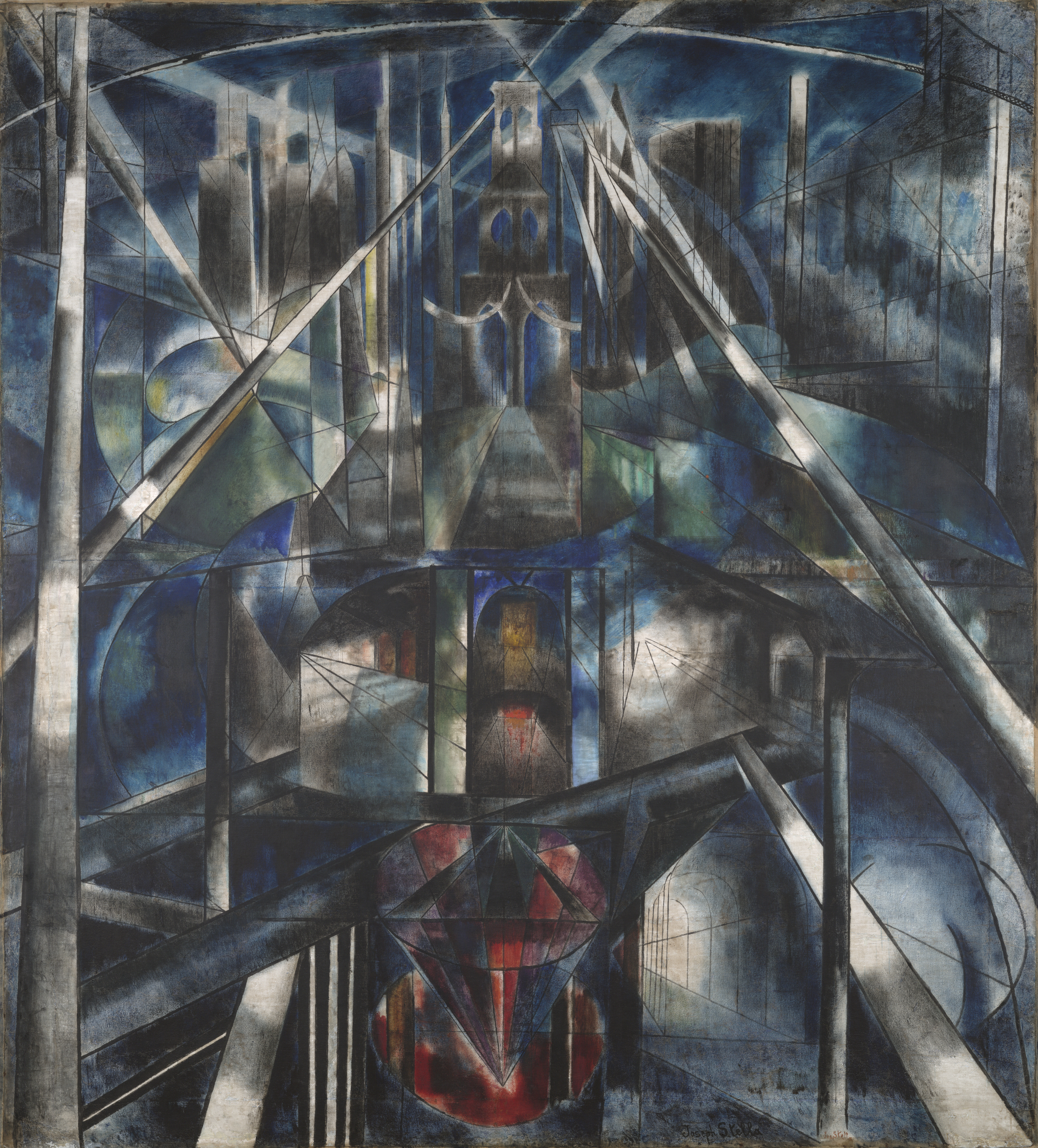
Students then learned some specific steps about how artists do make abstractions from specific objects. They learned to disassemble the image into shapes, to rearrange them and to change the size/scale.
They were then invited to choose one the the Portland bridges and to make an abstraction of that bridge.
They did a fabulous job!!!!
Please admire some of the paintings below.
4/12/15
3rd grade students have been working on geometry and paper engineering in art class. Instead of making the large robots of last year, students are given experience and becoming familiar with 3-D shapes, cubes and rectangles. They have also been taught some basic paper engineering tricks, of making cylinders and using attachments of "legs," in preparation for making their Monster.
The children were taken through a series of exercises, with the hope and goal that if they get to create cubes and 3-D rectangles from scratch (drawn themselves with graph paper) that the practice will help them visualize the shapes in other assignments. Students were also taught a variety of "zentangle" techniques (new, trendy ways of pattern making) and ultimately asked to decorate their cubes and later their paper "monster" using the patterns of their choice.
Many, many students did a great job pulling all their learning together. Also some students took it further -yay!- but adding even more features to their monsters - like wings and accessories.
Here are a few. Many will be on display at the Umpqua Back in Multnomah Village, sometime in the next few weeks.
2/23/15
I love the pictures of the 3rd graders struggling with their Chinese paintings and writing.
They too seem to love the challenge.
2/13/15
Students in Ms.Burak's class had a chance to do their Chinese brush painting inspired by a common Chinese icon. They learned about the symbolic meaning of a fish, a peach, plum blossom, bat, crane, phoenix, unicorn and dragon.
Ask them which one they painted and what it means.
Once they got the hang of it they did a very good job. Here are some of the results. Very, very nice.
2/6/15
Chinese New Year
Students have begun to look at the calligraphic art of Chinese brush painting.
They watched a quick video explaining the basic history of the art.
They even got to experiment with chinese brush strokes and had the opportunity to invent some of their own.
This is a fun process and hopefully a reminder of the universal need to "name" something in order to teach it or refer to it in any way.
And as Americans, our culture is so different from the Chinese as our students are encouraged to "invent" rather than complete rote following of pre-perscribed technique/brushstrokes and movements.
As a side bar, students were given some resources and time to make a New Year's greeting (in poster form) of their own, "writing" in Chinese and drawing a Sheep/ram, as we are entering that year.
Here is one picture to give you an idea of the results.
They did a great job and will be taking some home today and next week.
1/21/15
Some FANTASTIC paintings!
1/14/15
Here are the students painting away.
1/8/15
Students have begun their Munter house paintings.
Here is a sneak peak of their start.
1/5/15
Happy New Year!
Students are going to continue to think about architecture as they look at the paintings of Gabriele Munter.
She was a German painter at the turn of the century, who studied with Kandinsky and helped define the modern interpretive approach to painting.
She uses color interpretively and she renders scenes simply.
Here is the power point I will use with the students as they prepare to paint a house or their house, using simpler forms and interpretive color.
Munter presentation
And here are a few more of her paintings.
Enjoy! She was amazing.


12/9/14
Students have been focused on drawing buildings, mostly houses and they have applied that skill and experience to making a print.
Students were introduced to printmaking the past 2 weeks and have produced their own "editions."
11/18/14
Students are being introduced to some of the broad concepts of architecture and building. The topic will be a focus for several projects and will be revisited in the spring.
We talked a little about how buildings are built and the role of an architect.
Students have been given multiple examples of houses and are practicing drawing the buildings.
Here are a few examples.
They are doing a very good job.
10/15/14
Some completed plant drawings with interpreted backgrounds.
All are wonderful and soooo different from each other!
10/4/14
We have moved on to a lesson is realism. This is important to touch on in every grade level, to help the students improve their skills and give them more confidence in this area. Everyone admires artists with the ability to draw realistically, so having this ability (or lack of fear!) is an important part of an art education.
Recently a parent told me her child felt like they could not draw realistically as a 3rd grader. My response is:
I do not have any expectation that a 3rd grader would be able to draw at a highly realistic level. That just does not happen developmentally at that level, except in rare situations.
What I do expect is effort and giving it a try. The results that we all admire and enjoy looking at is an interpretation of realism, that has a confidence and charm all its own. I think it is even better that straight realism.
As an art lover I celebrate what the students naturally do!
Students are drawing plants, then are being asked to make their best drawing to be completed in a particular style using a particular technique. (I won't bother explaining until I post some examples here).
This is what they are looking at:
9/17/14
Some of the Lichtenstein self-portraits are complete. this is a really nice project as it gives the students a chance to tell about themselves.
I am... (thought bubble)
I like to ...(speech bubble)
sound, that best describes them.
I'll post them below followed by some interesting pictures of Lichtenstein in his studio.
Now for Lichtenstein in his studio.
Just FYI
I am excited about my second year at Capitol Hill School.
As you know we have 2x 3rd grades + 1x 2/3 blended class. I will be seeing the students in the 2/3 class together, so I plan to teach them using the 3rd grade curriculum, usually.
Here is the self-portrait lesson I will begin the year with, inspired by Roy Lichtenstein.
Lichtenstein lesson
Not all our art lessons will be or are in power-point form, but this one is. Enjoy.

Here are a couple of the rough drafts:
4/24/14
Here are many of the Bridge Abstractions.
4/12/14
Since spring break we have been inspired by the work of Joseph Stella and his Brooklyn Bridge series. Students just completed their bridge study in the classroom and according to their teachers, they were not tired of bridges at all, in fact they are perfectly primed for this study.

Joseph Stella
 | |||
| Joseph Stella |
We approached the project by looking at Stella's interpretation of the bridge and talked about abstraction from reality.
Students chose one of the Portland bridges and went through a process of:
1. Drawing it simply but realistically
2. "Disassembling" the drawing into the overall shapes and component shapes it is made from
3. Taking those components and rearranging them in different orientation, varied size and scale and repeating the shapes as needed.
4. Students were to experiment by sketching these ideas, then choose one to develop into a watercolor painting.
I had wondered if 3rd graders would "get" abstraction, this is a new project for me. Well! they had no problem with it, and I think the results are quite exciting.
Here is how they are progressing:
3/14/14
Robots are complete now and the students did a fine job on their inventions.
Each Robot has a role, as it was built to serve humans. It should have at least 3 accessories showing it's responsibilities.
It is required to have;
- an on/off switch
- a dial or control to select activity or function
- a gauge to show a level of supply, fuel or stored energy.
I think the students had a lot of fun making their robots and a welcome, relaxed change from the rigors of a typical school day.
Some robots fit in the hall display case. Others will be shown at the CH ART Show, coming soon after spring break and still others will be brought home this Friday.
1/30/14
ROBOTS
robots at weddings
And each robot will need 3 clues as to its designed purpose.
Friday/tomorrow, partners will be announced and students will brainstorm a list of jobs a robot can do. Partners will begin designing robots.
Materials will be limited (on purpose) and students will need to use their newly learned geometry skills to fabricate a robot.
The project is loads of fun and a huge mess.
Students can bring in any junk mechanical castoffs, washers, bolts, spray nozzles, any kind of stuff that may add to the mechanical-ness of the robot. Donations welcome!
1/22/14
Geometric shapes and paper sculpting.
1/5/14
This week students will learn some techniques of making 3-dimensional shapes from paper (2-d). I call this particular activity "paper playground" as students are taught several different techniques and them asked/allowed to make a paper playground using their imagination and ingenuity with lots of paper and tape. Its fun and hopefully support their understanding of geometry.
11/25/13
The Gabriel Munter paintings have begun and the students are off to a strong start.
Here are some previews:
11/9/13
Architecture is a topic we will revisit several times this year.
Students were introduced to the concept and reviewed what they knew and learned a few new things. Two of my main points is that architecture as we know it is intentional, so every part of the design has been somebody's decision. And historically buildings were made with local materials, reflecting local needs/requirements and resources.
Students were introduced to the paintings of Gabriele Munter. They observed their moody, seasonal qualities.
Students are going to draw and paint their own house/apartment in the style of Munter.
They spent the first class just looking at reference pictures of houses and practiced including the features and basic details.
I think this shall be fun.
10/7/13
Well most of the 3rd graders are done with their plant drawings. In the final project they were asked to drawing one of the plants they liked drawing. Then they were to get creative with it. They were to put some interesting texture within the leaves with the fine tip sharpie and then leave the plant the color of the paper while adding vivid color to the background. I introduced them to the art concept of positive and negative space, and asked them to see their plant as the positive shape that is left blank and the negative space- the background is getting all the bright attention.
The students did a great job. Really!
Here are a few examples:
9/23/13
Today students were introduced to some tips on how to draw realistic plants. Look at them! as general shapes, what shape is the leaf, how does it attach to the plant, what direction does it hang, does it point up, sideways or down and what detail can you see of the veins?
This may be the first time students have had a chance to draw foliage. They did quite well and I know I will see improvement in the next session as well. The plan is to spend another class, on Friday practicing their drawings and next Monday, students will begin a final version that invites them to do accurate observation and some imaginary color additions.
These students sure focus and do strong work.
Here are some examples from today:
Some of our plants:
Pretty good don't you think?
9/18/13
3rd grade-Third grade is beginning with a traditional self-portrait project I learned from their teachers. It may look a tiny bit different, but you will recognize the essence. Students received instruction on how to draw a face, but this was tied in with a language arts activity in which they brainstormed a list of descriptive words for themselves. The words were then incorporated into the art work. Students learned to use oil pastel for detail and used watercolor to add the overall color. The work is good! And I know some parents will be surprised with the creative way the students represented themselves.



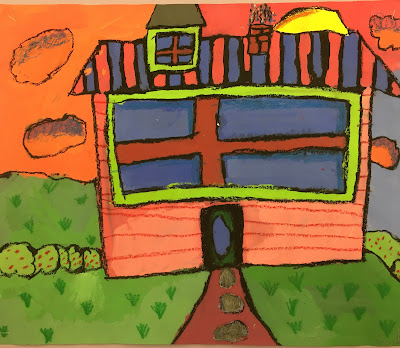











































































































































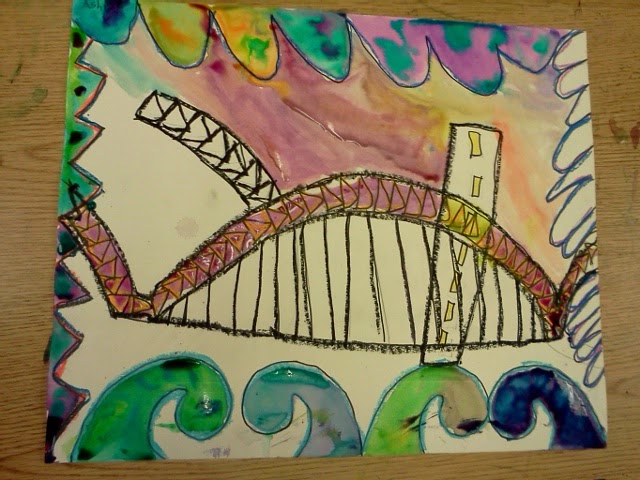







































.jpg)









No comments:
Post a Comment